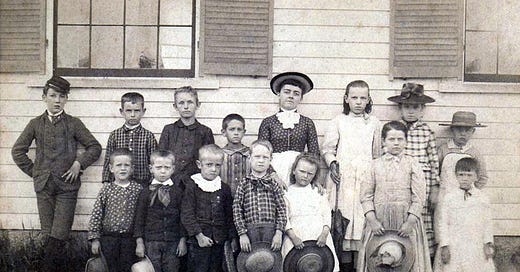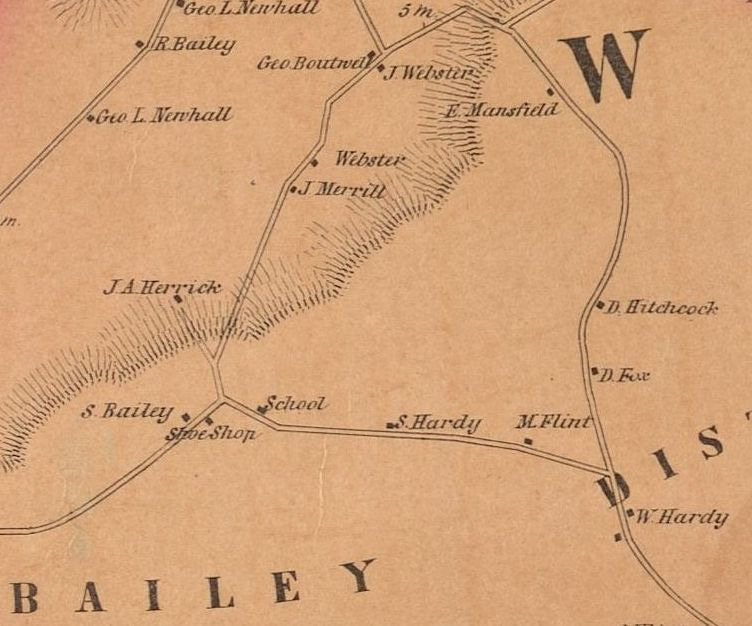If asked to describe the average school in the United States, you might think of a large brick building with wide hallways or a university campus with thousands of students. In a rural area, you may think of a regional school that serves small towns.
We owe our modern concept of a school to Horace Mann and improvements in technology and infrastructure. Mann argued for universal public education as a politician and standardized the secular classroom and curriculum we know today. Modern roads, cars, and school buses allow students to travel farther to school. Often coupled with a general increase in population, towns opted for fewer, but larger facilities in the 20th century.
Before these innovations, Andover managed a flurry of rural, one-room schoolhouses. A map of Andover drawn in 1852 shows a grand total of 18.
People called them “outskirt schools” or “squadron schools”, but most often “district schools”.12
ACHC #1969.019.1, map of Andover, 1852, showing all 18 school districts
The town established its first district school in 1750.
A typical example is the Bailey District, named for a prominent family in the area. Residents were far from the town center and demanded a school in their neighborhood.
The first Bailey Schoolhouse, built 1784-1790, sat on Haggetts Pond Road near Wood Hill.3 It was independent in most respects and had little oversight from the town at large. The school was public but functioned much like a subscription school.4
A subscription school meant parents paid depending on how long they decided their children would attend. In the Bailey District, all residents contributed to the school, not just parents of students.5
Sometimes they received external financial support. Samuel Phillips, better known as the founder of Phillips Academy, funded Andover’s district schools as a way to prepare local students for his institution.6
The Bailey District. If you zoom in you can spot the school (see next image).
According to Sarah Bailey’s Historical Sketches of Andover, tradition stipulated that schoolhouses must be as close to the geographic center of the district as possible.
When Andover selectmen changed district boundaries in 1795, the schoolhouse was no longer in the center of their district.
They were serious about remedying the issue.
Residents tore down their schoolhouse of just five years and built a new one on Bailey Road near Pleasant Street. The new location was unideal for building, perhaps because of the surrounding wetland, but satisfied their requirements.
Another zoom. See the building labeled “School”.
The second building served the neighborhood for over sixty years. Students ranged from 4 years of age to 18 and learned reading, writing, and arithmetic under a single teacher or master/mistress. An elected neighborhood Prudential Committee oversaw most administrative functions.
Albert Hardy, a student in the 1860’s, recalled the pleasant atmosphere at the Bailey School. Although 50 kids had to fit into the small room, they spent most of their day playing outside. He climbed the nearby hills, skated, and played games like “Run, Sheep, Run”.78
The administrative side was less pleasant. Little funding over the years put the building into disrepair.9
Other district schools had a similar fate. In 1866, the town took over the district schools to form a municipal system managed by a School Committee (the same one as today). The Bailey School now had a standardized curriculum.
ACHC #1980.098.1, Bailey School District class 1889
The town recognized the need for repairs and replaced the dilapidated Bailey Schoolhouse in 1868.
Located 150 feet from its predecessor, the third Bailey Schoolhouse was similar to its contemporary counterparts. It was Greek Revival in style and had two front doors, the left for boys and the right for girls. This seemed to serve little purpose save hanging coats because the genders would immediately reunite in the building’s main room.
The main room had rows of desks bolted to the floor with a raised platform for the teacher. A bathroom and well were outside.
The Bailey School closed in 1926 in response to the consolidation trend in the 20th century. Students relocated to schools in other districts.
The town sold the building in 1940 and the new owner converted it into a residence. The home stands at 47 Bailey Road.10
By the mid-20th century, the one-room schoolhouse of Andover was extinct.
Did you, or did anyone you know, attend a one-room schoolhouse?
Last modified February 28, 2021.
Sarah Loring Bailey, Historical Sketches of Andover, (comprising the present towns of North Andover and Andover), Massachusetts (Boston: Houghton, Mifflin and Company, 1880), 523, https://archive.org/details/historicalsketch00bail.
See Bailey, Historical Sketches of Andover, 517-532 for a more complete history of Andover’s early schools.
James S. Batchelder, “47 Bailey Road,” Andover Historic Preservation, Andover Preservation Commission, January 14, 2016, https://preservation.mhl.org/47-bailey-road.
Abiel Abbot, History of Andover from Its Settlement to 1829 (Andover: Flagg and Gould, 1829), 113, https://archive.org/details/historyofandover00abbot.
James S. Batchelder, e-mail message to author, February 26, 2021.
Bailey, Historical Sketches of Andover, 524.
Batchelder, “47 Bailey Road”.
See “Database of Games” for a description of a version of “Run, Sheep, Run”.
Batchelder, “47 Bailey Road”.
Ibid.








